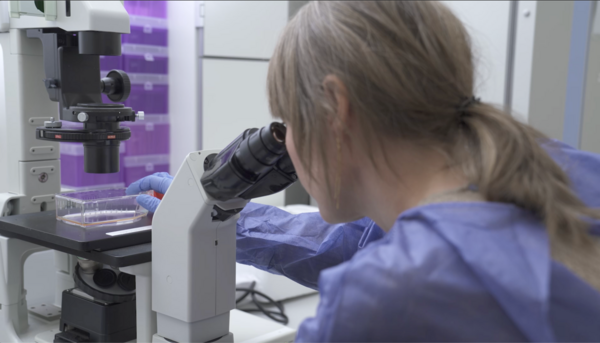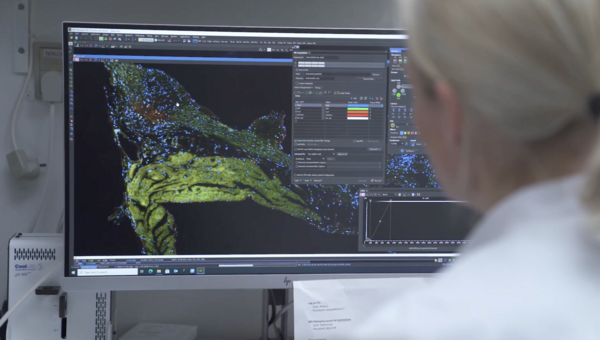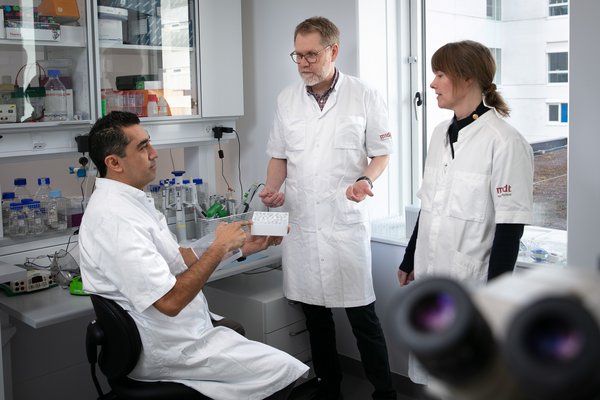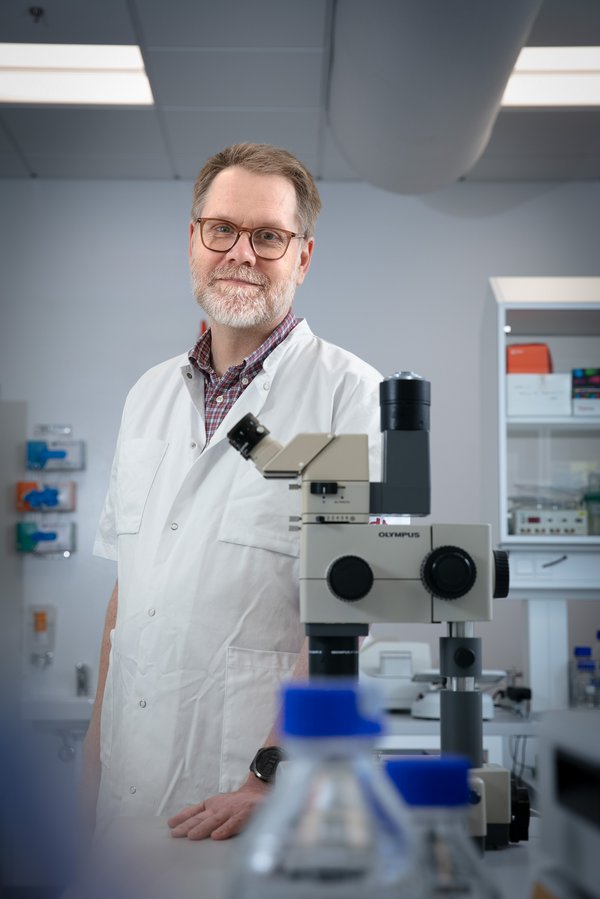Searching for new drug targets in identity-changing smooth muscle cells
The THOR project is a story about a very common cell type: The smooth muscle cell or, in short, the SMC. This cell type is necessary for a well-functioning cardiovascular system, but it also has a dark side because it can promote the development of common cardiovascular diseases.
“Smooth muscle cells are really interesting cells, I think,” says Jacob Fog Bentzon who was heading the THOR project. “They are highly plastic. In a healthy person, they regulate the elasticity and diameter of our blood vessels, but during disease processes, they can lose their normal contractile phenotype and adopt a whole new set of behaviors,” he explains. Jacob Fog Bentzon is an expert in atherosclerosis, and previous research from his lab at Aarhus University has shown that SMCs are responsible for many of the cells that are present in atherosclerotic plaques.
Focusing on smooth muscle cells in atherosclerosis
Atherosclerotic cardiovascular disease, ASCVD, is the leading cause of death and disability in the world. The disease develops throughout life with no or little symptoms as the plaque develops inside the blood vessels. Eventually, however, the plaque can rupture and form a blood clot, which blocks the free passage of blood. The resulting lack of oxygen leads to infarction in downstream tissue. “If the blood clot is placed in the arteries supplying the heart and brain, it can have devastating consequences such as heart attacks and ischemic stroke. The THOR project aimed to find new drug targets to avoid these consequences of ASCVD by targeting the SMCs,” Jacob Fog Bentzon explains.
Many patients don’t benefit sufficiently from the current drugs for atherosclerosis, which target the risk factors for ASCVD, such as high blood cholesterol levels. “Today’s drugs work primarily by lowering cholesterol,” states Mette Nyegaard, an academic partner in THOR, and continues: “But genetic studies show that there is much more to atherosclerosis than just lipids. In fact, genetic studies point strongly towards the involvement of smooth muscle cells."
Recent research has shown that SMCs, which change their identity, are a key determinant of the development of atherosclerotic plaques. “In atherosclerosis, the arterial SMCs lose their normal contractile phenotype and start proliferating. Some of the new cells re-acquire SMC phenotype and stabilize plaques against plaque rupture. But others end up as lipid-filled foam cells or collagen-producing cells, which likely have a detrimental role”, Jacob Bentzon says. He explains that the SMCs’ abundance and their ability to change identity makes them obvious candidates for extra attention in relation to drug discovery: “With the THOR project, we wanted to investigate the role of smooth muscle cells in atherosclerosis. Our goal was to pave the way for drugs targeting a central disease mechanism instead of the risk factors,” he says.

A strong interdisciplinary team investigated the role of smooth muscle cells
Knowledge on atherosclerosis and SMCs was required for the THOR team to reach their goal. But competencies within genetics, vascular biology and drug targeting strategies were also necessary. “All these competencies are to some extent present in both of the academic groups and in our group of collaborators from Novo Nordisk,” Jacob Fog Bentzon says. According to him, the overlapping of competencies has been a great advantage to the THOR team, as they have understood each other very well. He also believes that the mutual understanding has fostered excellent collaboration and new ideas during the project.
Although the THOR project fits nicely within Jacob Fog Bentson’s own key interest areas, he alone was not the only originator of the project. Instead, the THOR project was co-created by both academia and industry partners as required by the collaboration platform ODIN, which funded the project. ODIN projects must also collaborate in a no-IP setting and share knowledge and results openly with any interested partners.
Jacob Fog Bentzon describes the open collaboration as fruitful: “I'm really enthusiastic about this way of working with companies. I've worked in closed industry collaborations before, but it has never been as fruitful for us as this project. This, of course, has to do with our collaboration partners, who have been great, but it is also facilitated by the framework of ODIN.” He highlights the strong mutual interest in the general understanding of SMCs as key to the fruitful collaboration with industry.
Head of the scientific team from Novo Nordisk, Michael Nyberg, agrees: “Understanding the role of SMCs in atherosclerosis and how to target these cells is not a one-man job. Here, a team of dynamic, interactive, innovative, and interdisciplinary members were truly needed to fully disclose the complex mechanisms at play.”

3 steps to identify potential druggable genes in smooth muscle cells
The partners in the interdisciplinary THOR team all played important roles in the search for druggable targets relating to SMCs. Before starting the project, the THOR team had decided on a 3-step plan for identifying potential drug targets. “Our approach was to combine human genetics studies with functional studies in SMCs and knowledge about drug target selection,” says Jacob Fog Bentzon.
First, the geneticists searched several human genetic databases for genes linked to ASCVD. In the identified list of genes, they filtered out the genes that were in any way related to cholesterol. This resulted in a list of nearly 400 genes.
In the second step, the 400 genes were matched against public databases of single-cell gene expression data from human atherosclerotic arteries. The task was to identify the genes that were predominantly expressed in SMCs and the cell types that they can change into. The Novo Nordisk team identified 20 candidate genes from the previous 400 genes.
After the first two steps were performed with computational methods, the third step involved regular lab work. The THOR team investigated the roles of the 20 candidate genes from step 2 in three different SMC phenotypes. “We steered the smooth muscle cells into three different phenotypes: Proliferative smooth muscle cells that give rise to the many cells in plaques; more contractile smooth muscle cells induced by cyclic stretching; and lastly foam cell SMCs, which we induced by cholesterol overloading. Gene function of the candidate gene was then tested in knockdown studies, where each gene was temporarily inactivated,” says Julian Albarrán-Juárez, a key team member leading this part of the work.
By sequencing RNA, the team analyzed how each of the 20 candidate genes affected various aspects of SMC function in the three phenotypes. This step required the expertise of a bioinformatician, who obtained an integrated overview of the biological pathways regulated by the 20 candidate genes. Jacob Fog Bentzon explains that this work led both to expected and unexpected results: “We observed that many genes linked to human atherosclerosis regulated the contractile phenotype of SMCs, which confirmed our pre-existing hypothesis. But we also observed that previously scarcely explored pathways in SMCs, such as interferon signalling, were commonly affected.”

The THOR project will pave the way for future projects and downstream innovation
The 20 candidate genes that were identified as potential drug targets and all the RNA-sequencing data from the knockdown screen are shared with the public to increase the likelihood that all candidate genes are explored in downstream projects. “Everyone who’s interested can access the data through the ODIN repository at the Zenodo website", Jacob Fog Bentzon says and refers interested researchers to the website at https://zenodo.org/records/7327363.
The team is now following up directly on the THOR project by testing selected drug target candidates and molecular pathways in refined cellular models and in animal models of atherosclerosis. The hope is that it will be possible to demonstrate in vivo efficacy of blocking or stimulating one or more genes analyzed in THOR.
“The findings from the THOR project offer a novel map of disease-associated pathways within SMCs,” says Jacob Fog Bentzon. “We hope and expect that this rich data will support drug development – and drug repurposing – in the fight against atherosclerosis”, he concludes.
